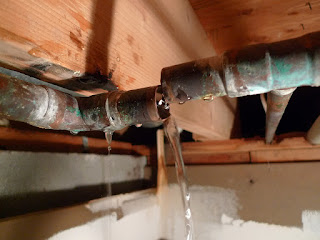
Whether caused by a flooding or a simple leak in the roof, water damage can have catastrophic consequences on your home. While destroying your property, your furniture, electronics, it goes so far as to put your health at serious risk. Not to mention the damage it does to the resale value of your home.
Heavy rain, quick melting of snow, flash floods increase the possibility of water damage, made worse if your home lacks adequate waterproofing. Causes for water damage can range from a flood to a broken pipe, a sewer backup, broken fixtures, plumbing leaks, foundation cracks, clogged toilets,
overflowing washing machines,
faulty drainage systems, etc.
Water damage tends to start out unseen. The first and most critical step to fixing it is detecting it. It is important to have it remediated as soon as possible to prevent it from causing problems some of which are listed below.
Discoloration and Sagging
The unmistakable sign of a leak is discoloration of the ceiling, the beams roofing underlayment or of the walls. This can be considered the most minimal long-term water damage. When water accumulates in one spot resulting in a sudden bulge or change in the ceiling or walls, it causes the structure to ‘sag’.
Structural Damage
When a leak occurs, water seeps into drywall and gets absorbed. It causes the material to warp, chip or swell. If not treated quickly enough, it poses danger to the home’s structure.
- Constant exposure to water can result in the growth of fungi or mould, which then rots the structural wood. A worst case scenario is when the area at risk is an important structure of the house, like a support beam. It is of paramount importance to fix the leak and repair the damage. If ignored, it might just bring your roof down.
- Concrete is more durable than wood. But, in cases such as flood damage, the accumulation of moisture in cracks and crevices can cause a host of problems including corrosion of steel inside the concrete structure.
- Water damage can also affect electrical wiring, the electrical circuit box, and electrical equipment in the house. This could risk the occurrence of power breakdowns at the least, and in worse situations, electrical burns and electrocution.
Mildew and Mould
One of the most common consequences of water damage is the growth and spread of mould in the house. Moisture trapped in a confined space quickly invites these microscopic fungi which destroy everything they touch and then continue to spread to other areas. Mould can potentially weaken the framework where a leak is located, thereby weakening the foundation of your home.
Health Risks
Mould produces spores, which when come into contact with water, proliferate, and begin to pollute the air. This poses a serious health risk. From aggravating allergy and asthma symptoms, from causing breathing difficulties, to respiratory diseases, mould affects children, the elderly and people whose immune systems have already been compromised.
As soon as a residence or any structure has been compromised by water damage, immediate cleanup and remediation is very important. If it is extensive, and you attempt to treat it yourself, you may not manage 100% damage control. In time, the lingering effects of the damage may come back to haunt your home and family. Your safest move would be to call in the professionals. Bio Cleanse Services is all equipped to help you in your toughest times. Call us on 0412 547 547 or visit our website to know more.

